Mt. Fuji is world-renowned for its distinct and graceful conical shape. Japan's highest peak, at 3,776 meters above sea level, Mt. Fuji is an active volcano, and shows different expressions in harmony with the surrounding scenery throughout the four seasons. Because more than 300 years have passed since the last eruption, volcanic experts agree that "the volcano will eventually erupt, although the timing and magnitude are unpredictable." The importance of an early disaster prevention system has been emphasized, as a violent eruption would cause serious damage even in the Tokyo metropolitan area.
In late March, the Mt. Fuji Volcano Disaster Prevention Council (chaired by Shizuoka Governor Heita Kawakatsu), consisting of Yamanashi, Shizuoka, and Kanagawa prefectures, as well as the national government, developed an updated Mt. Fuji Eruption Evacuation Basic Plan to minimize the human injuries that could result from the eruption of Mt. Fuji. In principle, it is recommended that, in the event of an eruption, healthy residents in areas without danger of pyroclastic flows (a fast-moving current of hot gas and volcanic matter) or volcanic rocks evacuate on foot to avoid being left behind owing to traffic congestion. The plan includes guidance on calling climbers and tourists to descend the mountain before the declaration of volcanic alert Level 3 (mountain entry restrictions) as well as residents seeking refuge in nearby indoor facilities to avoid ash falls.
This updated basic evacuation plan is the first revision in nine years following the revisions to the Mt. Fuji Volcanic Hazard Map in March 2021. It reflects the latest findings regarding a Mt. Fuji eruption and is aimed at protecting lives and livelihoods through safe evacuation while aiming to "leave no-one behind."
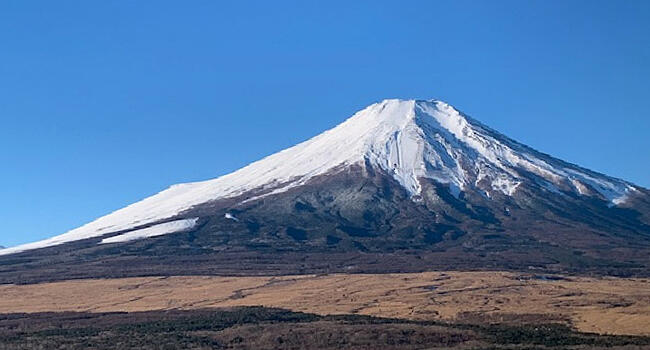
(photo taken in December 2022)
The new hazard map revealed increased impacts of an eruption
Upon review, it was revealed that the impacts of the eruption would be more far-reaching within a shorter time than originally estimated. The number of evacuation target population has increased significantly from approximately 16,000 to approximately 116,000.
The new hazard map has been extensively revised from the map created in 2004, taking into account the latest scientific findings on lava flows and pyroclastic flows as well as the results of computer simulation analysis. First, the new hazard map incorporates additional craters based on new research and the possibility of subterranean craters being buried underground. This considerably expanded the estimated range of craters. In addition, the timeframe for studying past eruptions subject to damage assessment was revised "from 3,200 years ago to the present" to "from 5,600 years ago to the present."
The volume of lava flowing from the crater over the ground surface increased from 700 million cubic meters to 1.3 billion cubic meters, while the volume of pyroclastic flow, consisting of volcanic ash and rocks, flowing down the slopes at high speed along with volcanic gases, increased from 2.4 million cubic meters to 10 million cubic meters. It was also discovered that the lava flows far exceeded previous estimates and could have reached as far as Suruga Bay in Shizuoka Prefecture, Odawara City in Kanagawa Prefecture, Otsuki City in Yamanashi Prefecture, affecting a total of 12 cities and towns.
Computer simulation analysis revealed that the lava flows take less time and travel farther than when the map was created in 2004. It was also indicated that the pyroclastic flows could reach a broader area than originally expected. The results also suggest that snowmelt-type volcanic mudflow, in which snow melted by pyroclastic flow runs off, entrapping sediment and moving faster along rivers and valleys, may reach some urban areas in a short time.
For almost two years, the Mt. Fuji Volcano Disaster Prevention Council has been working to formulate an updated evacuation plan using the new hazard map to reassess the evacuation target areas and those who should be subject to evacuation.
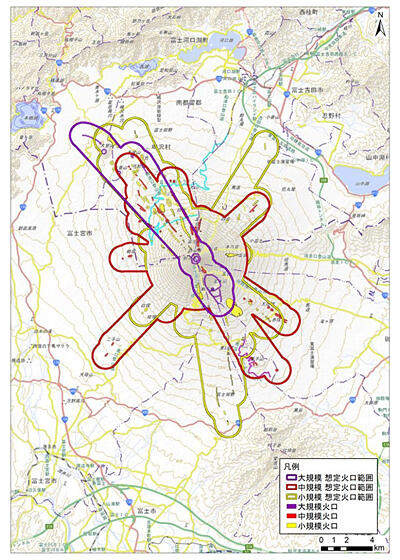
(Provided by the Mt. Fuji Hazard Map Study Committee, Mt. Fuji Volcano Disaster Prevention Council)
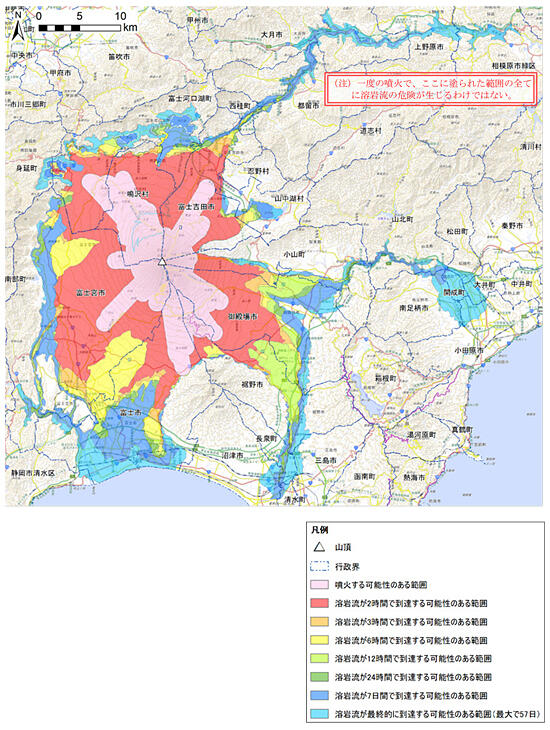
(Provided by the Mt. Fuji Hazard Map Study Committee, Mt. Fuji Volcano Disaster Prevention Council)
Approximately 180 eruptions over the last 5,600 years
It has been confirmed that Mt. Fuji has erupted approximately 180 times over the last 5,600 years. According to the Mt. Fuji Volcano Disaster Prevention Council, 96% of these eruptions were small or medium in scale. In the "Jogan eruption," which is said to have occurred between 864 and 866 AD, a large amount of lava covered a vast sea of trees (Aokigahara Jukai Forest) at the foot of the mountain.
The last confirmed eruption of Mt. Fuji in reliable records is the "Hoei eruption" in December 1707, on the southeast flank of Mt. Fuji. The explosive eruption lasted more than half a month, and a considerable amount of volcanic ash fell even in Edo (current Tokyo). Some experts believe that the Hoei eruption was triggered by a massive earthquake that originated in the Nankai Trough in late October 1707, before the Hoei eruption.
Although there has been no eruption after the Hoei eruption, a simple calculation of eruption history suggests that an eruption occurs approximately once every 30 years. The exact reasons for the absence of volcanic eruptions for over 300 years are not well understood. However, the long lapse since the last eruption serves as one of the bases of the viewpoint that "an eruption will occur eventually."
Mt. Fuji had been considered a dormant volcano until the 1990s because of long periods of non-eruptive activity. From 2000 to 2001, deep, low-frequency earthquakes frequently occurred beneath Mt. Fuji, which were believed to be associated with the underground movements of magma.
Target areas are now classified into six categories instead of five
The updated basic evacuation plan is formulated from the perspective of "early disaster prevention," based on the assumption that "an eruption will occur eventually." Nearly 800,000 citizens live in 27 municipalities in Yamanashi, Shizuoka, and Kanagawa, the prefectures that are subject to evacuation. Based on the new hazard map, the updated plan classifies evacuation target areas into six categories instead of the previous five, based on the projected arrival time of the lava flows. The evacuation targets are categorized into three groups: those who require support and time for evacuation, such as the elderly and disabled; other residents; and tourists. The plan also outlines in detail when and how evacuees should evacuate in each area.
The new evacuation target areas are designated as follows: Area 1 is an "area where a crater has possibly formed," Area 2 is an "area where pyroclastic flows and large volcanic rocks are expected," Area 3 is an "area where lava flows would reach within three hours," Area 4 is an "area where lava flows would reach between 3 and 24 hours," Area 5 is an "area where lava flows would reach between 24 hours and 7 days," and Area 6 is an "area where lava flows would reach after 7 days and up to a maximum of 57 days."
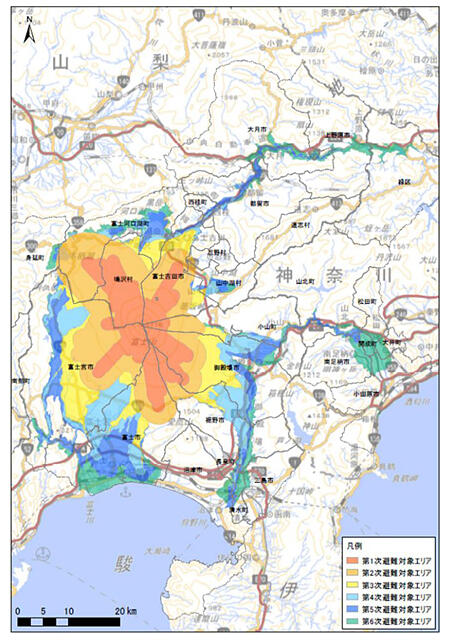
(Provided by Mt. Fuji Volcano Disaster Prevention Council/Geospatial Information Authority of Japan)
Lessons from the Great East Japan Earthquake for "evacuation on foot"
A key feature of the updated evacuation plan is that it now emphasizes "evacuation on foot," instead of the previous general rule of "evacuation by car." To avoid being left behind owing to traffic congestion and particularly to give priority to evacuation by car to people requiring support, among others, healthy residents in Area 3 where pyroclastic flows and large volcanic rocks are not expected and where lava flows are projected to reach within three hours should, in general, begin evacuation after the eruption and evacuate on foot to avoid traffic congestion, ensuring that they can move forward. Evacuation on foot is defined to include evacuation by bicycle or motorcycle. People requiring support are allowed to evacuate by car in any area.
The background of this policy stems from the lesson learned from the Great East Japan Earthquake in March 2011, when many coastal residents evacuated by car, causing severe traffic congestion on evacuation routes. They were swept away with their cars when the tsunami hit the coast, leading to tragic loss of life. In January 2022, when an undersea volcano erupted off the coast of Tonga, triggering tsunami warnings in Japan, traffic congestion occurred as cars in Amami City, Kagoshima Prefecture, headed toward higher ground.
While the policy was under development, residents in Area 1 and Area 2, where a crater may be formed or pyroclastic flows and large volcanic rocks may reach, were required to evacuate by car as soon as signs of an eruption, such as earthquakes or rumbles, were observed. This is because it was determined that evacuation after the eruption was not possible in these areas. National and local authorities are required to alert climbers and tourists at soon as the Japan Meteorological Agency raises the eruption alert to Level 3 by urging them to return home by bus or on foot. Schools will be closed when the alert is raised to Level 3.
In response to the updated plan, each municipality involved is required to determine who precisely can evacuate on foot and formulate a specific evacuation plan for all residents. Regarding the implementation of the policy for evacuation on foot, the Mt. Fuji Volcano Disaster Prevention Council states that "the speed of the lava flow will decrease in urban areas. If evacuation sites are located several hundred meters to several kilometers away from the lava flow invasion area, it would be sufficient (for evacuation by foot)." However, residents who heavily rely on cars as a means of daily transportation may be confused and concerned about evacuation on foot. Therefore, each municipality needs to ensure there is awareness and understanding among the local community.
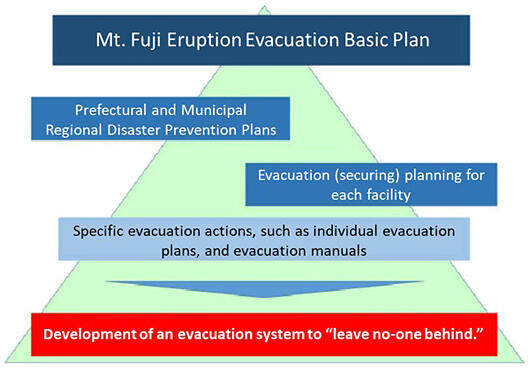
(Diagram provided by the Mt. Fuji Volcano Disaster Prevention Council and translated by Science Japan)
If a violent eruption occurs, the volcanic ash will severely damage the Tokyo metropolitan area
The risk of large-scale eruption of Mt. Fuji is considered low. Nevertheless, a violent eruption is expected to cause serious damage, covering a wide part of the Tokyo metropolitan area with up to 2 centimeters of ash, and as much as 10 centimeters in some areas. The population of these potential disaster hazard areas is estimated to be approximately 8.85 million. It has been noted that even a small amount of ash fall could cause train service disruptions, traffic congestion, and power outages, directly affecting the transportation network and lifelines in the metropolitan area and paralyzing metropolitan functions.
In March 2020, the government's Central Disaster Prevention Council released its first damage estimations for the Tokyo metropolitan area. The damage estimations are based on the Hoei eruption and assume three cases with different wind directions, among other variables; they extend consideration of damage from three hours to 15 days after the eruption if no countermeasures are provided in advance.
According to the estimations, overground trains will be unable to operate owing to ash falling on railway tracks in seven prefectures (Tokyo, Ibaraki, Saitama, Chiba, Kanagawa, Yamanashi, and Shizuoka), leading to service disruptions. Subways will also be suspended because of power outages if the ash, which contains moisture from rain, adheres to power transmission facilities. When rain wets volcanic ash, even a few centimeters of the ash can immobilize motorcycles, and similar vehicles, and up to 10 centimeters of volcanic ash is projected to fall in some areas. The ash fall is likely to worsen visibility and make driving difficult even for four-wheeled vehicles.
Paralyzed transportation infrastructure may have a tremendous impact on logistics, creating areas where citizens encounter difficulty obtaining essential supplies, with significant negative effects on people's daily lives. Furthermore, if ash falls while it is raining, there is a risk of communication failures because of ash adhering to the antennas of communication base stations and other facilities.
In addition, when volcanic ash is mixed with water prior to treatment at water purification facilities, it may cause water quality to deteriorate, rendering tap water undrinkable, and even causing a water outage. Ash falls during periods of rain would place old wooden houses at risk of collapse owing to their weight. The amount of volcanic ash requiring disposal following an ash fall disaster is estimated to be nearly 500 million cubic meters, which is approximately 10 times the amount of disaster waste generated by the Great East Japan Earthquake.
As a result, the mobility of people and goods in the Tokyo metropolitan area would be severely restricted, and the impact might extend nationwide, which could cause social upheaval. The Ministry of Land, Infrastructure, Transport and Tourism and other relevant ministries and agencies are now considering measures to mitigate the impacts of ash falls. It will not be easy, but the process is expected to produce effective concrete measures that gather the latest knowledge from the many fields involved in volcanic disaster prevention.
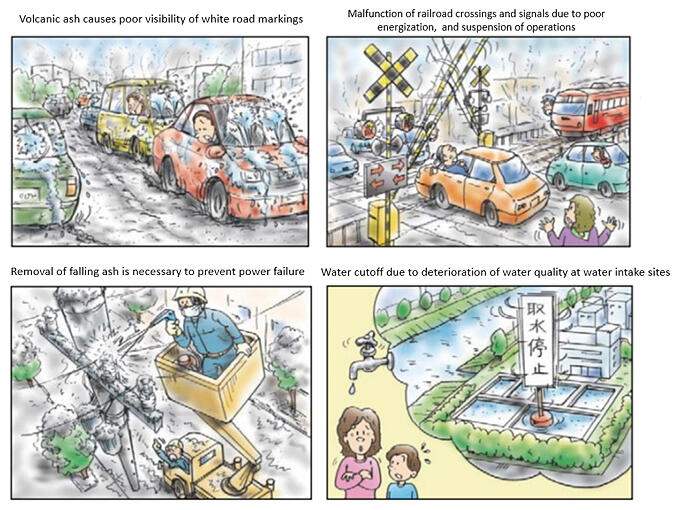
(Prepared and provided by the Central Disaster Prevention Council and the Working Group on Countermeasures for Wide-area Ash Falls from Major Volcanic Eruptions and translated by Science Japan)
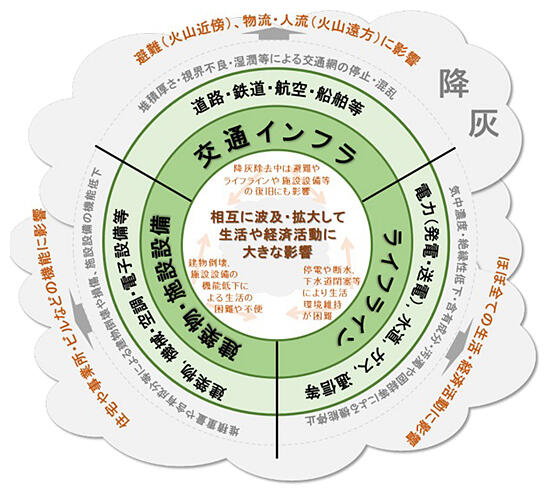
(Prepared and provided by the Central Disaster Prevention Council and the Working Group on Countermeasures for Wide-area Ash Falls from Major Volcanic Eruptions)
(UCHIJO Yoshitaka: Science Journalist)
Original article was provided by the Science Portal and has been translated by Science Japan.




